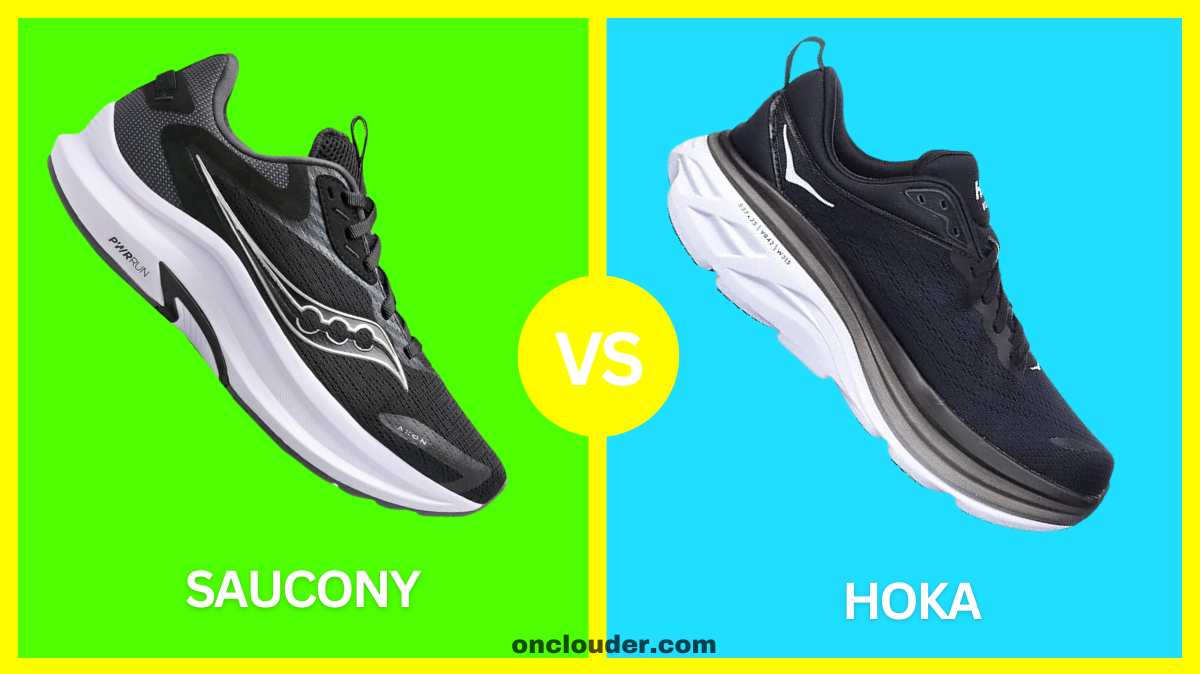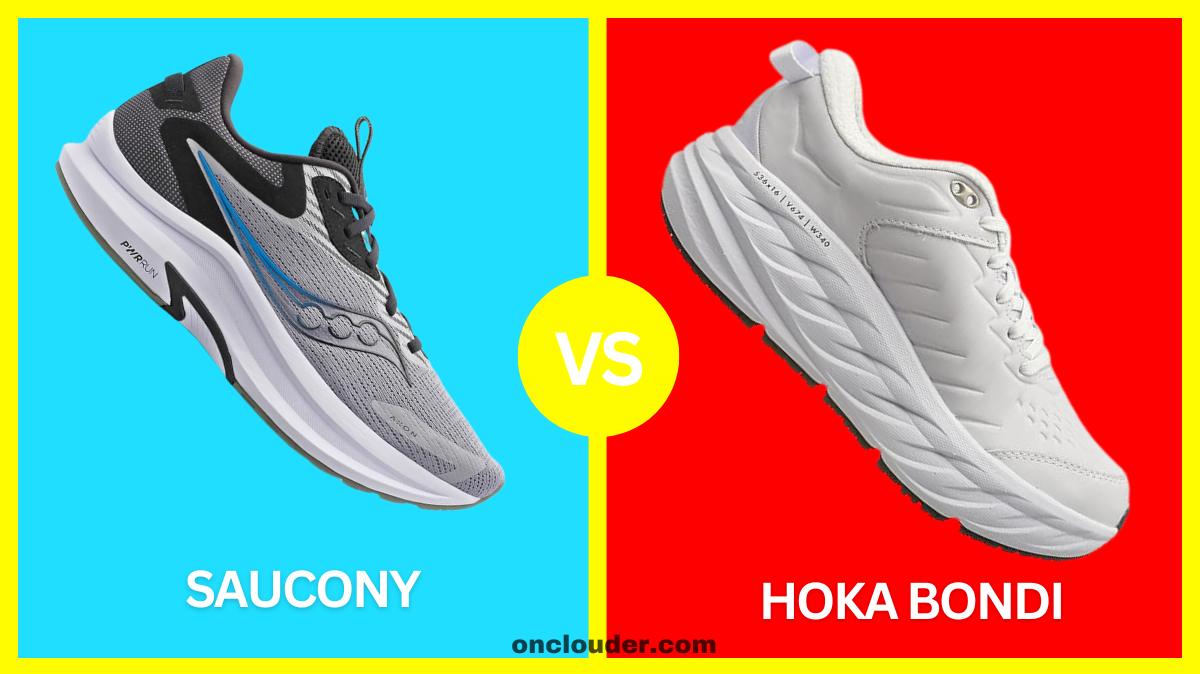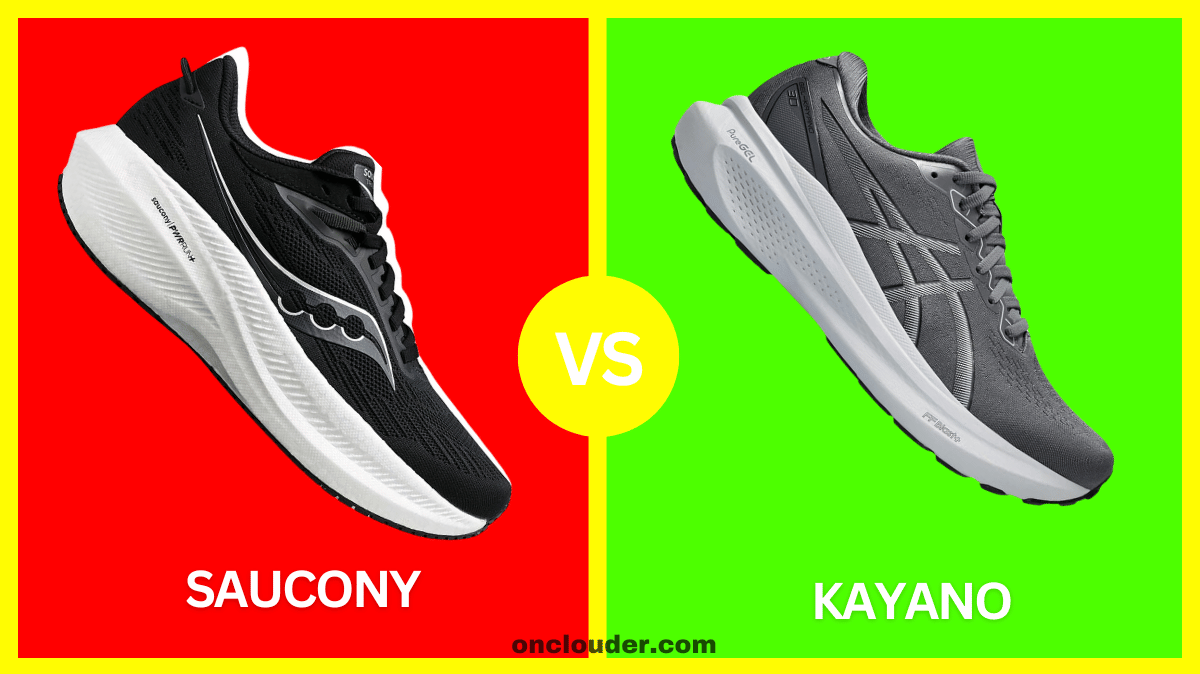Have you ever wondered about the differences between Saucony and Hoka shoes?
Whether you’re a runner, walker, or just someone who wants comfortable footwear, choosing the right shoes is super important.
We’ll compare these two popular brands to help you figure out which one might be best for you.

Contents
- 1 Quick Comparison: Saucony vs Hoka Shoes
- 2 A Quick Look at Saucony and Hoka
- 3 Comfort: Which Feels Better on Your Feet?
- 4 Cushioning: Soft Steps or Firm Footing?
- 5 Shoe Fit: Snug or Roomy?
- 6 Stability: Keeping You Steady
- 7 Durability: How Long Will They Last?
- 8 Breathability: Keeping Your Feet Cool
- 9 Quality: How Well Are They Made?
- 10 Style: Looking Good While You Move
- 11 Size: Finding the Right Fit
- 12 Materials: What Are They Made Of?
- 13 Weight: Light on Your Feet
- 14 Flexibility: Bend and Flex
- 15 Water Resistance: Staying Dry
- 16 Sole: The Bottom Line
- 17 User Reviews: What Do People Think?
- 18 Price: What Will It Cost?
- 19 Pros and Cons
- 20 Conclusion
- 21 Frequently Asked Questions
Quick Comparison: Saucony vs Hoka Shoes
The main difference between Saucony and Hoka shoes lies in their cushioning and design philosophy. Saucony offers a more traditional running shoe feel with balanced cushioning, while Hoka is known for its maximalist approach with oversized, ultra-cushioned soles.
This affects comfort, stability, and overall running experience for different types of runners.
Here’s a detailed comparison table for Saucony vs Hoka Shoes:
| Feature | Saucony | Hoka |
|---|---|---|
| Cushioning | Balanced, moderate cushioning | Maximum cushioning, oversized soles |
| Design | Traditional running shoe look | Distinctive, chunky appearance |
| Weight | Generally lightweight | Surprisingly light despite thick soles |
| Fit | Often narrower, snug midfoot | Typically wider, especially in toe box |
| Stability | Varies by model, some with specific stability features | Natural stability from wide base |
| Heel-to-toe drop | Usually higher drop (8-10mm) | Often lower drop (4-6mm) |
| Price range | $80-$200 | $100-$250 |
| Best for | Traditional runners, those preferring ground feel | Runners seeking maximum cushioning, long-distance runners |
| Durability | Good overall durability | Excellent cushion durability, potential for uneven wear |
| Breathability | Generally good breathability | Can vary, some models less breathable due to more material |
| Flexibility | Usually more flexible | Can be less flexible due to thicker soles |
| History | Established in 1898, long running heritage | Founded in 2009, known for innovation |
| Popular models | Ride, Guide, Triumph | Bondi, Clifton, Speedgoat |
| Terrain suitability | Road and trail options available | Excels on road, but offers trail options too |
| Professional use | Popular among traditional road runners | Favored by ultra-marathoners and triathletes |
In summary: Saucony and Hoka offer distinct approaches to running shoe design. Saucony provides a more traditional feel with balanced cushioning, catering to runners who prefer a responsive ride and closer ground contact. They often feature a snugger fit and higher heel-to-toe drop.
Hoka, on the other hand, revolutionized the market with their maximalist cushioning, offering plush comfort and shock absorption. Their shoes typically have a wider fit, especially in the toe box, and a lower heel-to-toe drop.
A Quick Look at Saucony and Hoka
Before we dive into the details, let’s get to know these brands a little better.
About Saucony
Saucony (say it like “sock-uh-knee”) is a company that’s been making shoes for over 100 years! They started way back in 1898 and have been creating all kinds of running shoes ever since. Saucony is known for making shoes that fit well and help you run faster.
About Hoka
Hoka, on the other hand, is a newer company. They began in 2009, which might seem like a long time ago, but it’s actually pretty recent in the world of shoe-making! Hoka is famous for their super cushioned shoes that feel like you’re running on clouds.
Now that we know a bit about each brand, let’s compare them in different areas that are important when choosing shoes.
Comfort: Which Feels Better on Your Feet?
When it comes to comfort, both Saucony and Hoka have their fans. But they feel different when you wear them.
Saucony Comfort
Saucony shoes are comfy in a way that feels more “normal.” They have enough cushioning to keep your feet happy, but not so much that it feels weird. Many people like this because it feels natural when they walk or run.
Hoka Comfort
Hoka shoes are like the marshmallows of the shoe world! They have tons of cushioning, which some people absolutely love. It can feel like you’re bouncing along on soft pillows. But not everyone likes this feeling – some think it’s too squishy.
Cushioning: Soft Steps or Firm Footing?
Cushioning is the soft stuff in shoes that helps absorb shock when your foot hits the ground. It’s super important, especially if you run a lot.
Saucony Cushioning
Saucony uses different types of cushioning in their shoes. Some models have more, some have less. They try to find a balance between softness and the ability to feel the ground under your feet. This can be great if you want a responsive feel when you run.
Hoka Cushioning
Hoka is all about maximum cushioning. Their shoes have thick soles with lots of soft material. This can be awesome if you have sore joints or if you run on hard surfaces a lot. The extra cushioning helps protect your feet and legs from impact.
Shoe Fit: Snug or Roomy?
How a shoe fits is super important. You don’t want it too tight or too loose!
Saucony Fit
Saucony shoes often have a snugger fit, especially in the middle part of the foot. This can be great for people with narrow or normal-width feet. They also usually have enough room in the toe box (the front part where your toes go) so your toes aren’t squished.
Hoka Fit
Hoka shoes tend to have a wider fit, especially in the toe box. This can be awesome if you have wider feet or if your feet tend to swell when you exercise. Some people find Hokas a bit loose in the heel, though.
Stability: Keeping You Steady
Stability in shoes helps keep your feet from rolling inward too much when you walk or run. This is especially important if you have flat feet or overpronation (when your foot rolls inward too much).
Saucony Stability
Saucony makes both neutral shoes (for people who don’t need extra support) and stability shoes. Their stability shoes have features that help keep your foot in the right position. They’re not too obvious, though, so they still feel pretty natural.
Hoka Stability
Hoka’s approach to stability is a bit different. Because their shoes have such thick soles, they naturally provide some stability. They also make specific stability models, but even their regular shoes can feel stable because of the wide base.
Durability: How Long Will They Last?
Nobody wants shoes that fall apart quickly! Let’s see how Saucony and Hoka compare when it comes to durability.
Saucony Durability
Saucony shoes are generally known for being quite durable. They use strong materials and good construction techniques. Many runners find that their Saucony shoes last for 400-500 miles of running, which is pretty good!
Hoka Durability
Hoka shoes, with their extra-thick soles, can be super durable in some ways. The cushioning often lasts a long time without getting compressed.
However, because the soles are so thick, they can sometimes wear down unevenly. Some people find that Hokas last about the same as Sauconys, while others say they wear out a bit faster.
Breathability: Keeping Your Feet Cool
Having shoes that let your feet breathe is important, especially if you’re exercising or if it’s hot outside.
Saucony Breathability
Saucony uses different materials in their shoes to help with breathability. Many of their models have mesh uppers (the part that covers the top of your foot) that allow air to flow through. This can help keep your feet cool and dry.
Hoka Breathability
Hoka also focuses on making their shoes breathable. They use lightweight materials and often have ventilation holes in their shoes. However, because Hoka shoes sometimes have more material (due to their thicker soles and overall design), some people find them a bit warmer than Sauconys.

Quality: How Well Are They Made?
The quality of shoes can make a big difference in how long they last and how good they feel on your feet.
Saucony Quality
Saucony has a reputation for making high-quality shoes. They pay attention to details like stitching and how the different parts of the shoe are put together. Many runners trust Saucony because they’ve been making good shoes for so long.
Hoka Quality
Hoka, being a newer company, had to prove themselves when it comes to quality. They’ve done a good job! Hoka shoes are well-made, with careful attention to how they’re constructed.
Some people worry that the unusual design (with the very thick soles) might lead to quality issues, but most users find Hokas to be well-made.
Style: Looking Good While You Move
While how a shoe works is most important, it’s also nice if it looks good!
Saucony Style
Saucony tends to have a more traditional look. Their shoes come in lots of colors, but the overall shape is usually what you’d expect from a running shoe. This can be great if you want shoes that look “normal” and that you can wear for different activities.
Hoka Style
Hoka shoes definitely stand out! Their thick soles and unique shape make them look different from other running shoes. Some people love this distinctive style, while others think it looks a bit weird. Hoka does offer their shoes in many colors, so you can usually find one that matches your style.
Size: Finding the Right Fit
Getting the right size is super important for comfort and preventing injuries.
Saucony Sizing
Saucony shoes usually fit true to size. This means that if you normally wear a size 7, a size 7 in Saucony will probably fit you well. They offer a good range of sizes, including half sizes, which can help you get a perfect fit.
Hoka Sizing
Hoka sizing can be a bit trickier. Some people find that they need to go up a half size in Hokas, especially if they have wider feet. Hoka does offer a good range of sizes, including wide options for many of their shoes.
Materials: What Are They Made Of?
The materials used in shoes affect how they feel, how long they last, and how they perform.
Saucony Materials
Saucony uses a mix of materials in their shoes. The uppers are often made from engineered mesh, which is lightweight and breathable. They use different types of foam for cushioning, like their PWRRUN foam, which provides a good balance of softness and responsiveness.
Hoka Materials
Hoka also uses high-tech materials in their shoes. Their uppers are usually made from lightweight, breathable fabrics. The thick soles are made from special foams that provide lots of cushioning without being too heavy. Hoka often uses their EVA foam, which is known for being light and soft.
Weight: Light on Your Feet
The weight of your shoes can make a big difference, especially if you’re running long distances.
Saucony Weight
Saucony shoes are generally pretty lightweight. They try to balance having enough cushioning and support with keeping the shoes light. Most of their running shoes weigh between 8 and 10 ounces (for a men’s size 9), which is considered fairly light.
Hoka Weight
You might think that with their big, thick soles, Hoka shoes would be heavy. But they’re actually not! Hoka uses super light materials, so even with all that cushioning, their shoes often weigh about the same as Sauconys. Some Hoka models are even lighter!

Flexibility: Bend and Flex
How flexible a shoe is affects how it feels when you move.
Saucony Flexibility
Saucony shoes usually have a good amount of flexibility. They bend where your foot naturally bends, which can make for a comfortable run or walk. Some of their shoes are more flexible than others, depending on what they’re designed for.
Hoka Flexibility
Hoka shoes, with their thick soles, might look like they wouldn’t bend much. But they’re actually designed to be pretty flexible! The soles have special grooves that allow them to bend with your foot. However, some people find that Hokas aren’t quite as flexible as other running shoes.
Water Resistance: Staying Dry
While most running shoes aren’t completely waterproof, some handle wet conditions better than others.
Saucony Water Resistance
Most regular Saucony running shoes aren’t specifically designed to be water-resistant. However, they do make some models that have water-resistant uppers, which can be great for running in light rain or on wet grass.
Hoka Water Resistance
Like Saucony, most standard Hoka shoes aren’t particularly water-resistant. But they do offer some models with water-resistant features. The thick soles of Hokas can sometimes help keep your feet a bit drier when running through puddles.
Sole: The Bottom Line
The sole of the shoe is super important – it’s the part that actually touches the ground!
Saucony Soles
Saucony soles are designed to provide a good balance of cushioning and ground feel. They often use different types of rubber in different parts of the sole to provide grip where you need it most. Many Saucony shoes have a design that helps you roll smoothly from heel to toe as you run.
Hoka Soles
Hoka soles are what make these shoes stand out. They’re extra thick, with lots of cushioning. Hoka uses a curved design they call a “rocker” that’s meant to help propel you forward as you run or walk. The soles often have special patterns to provide grip without adding too much weight.
User Reviews: What Do People Think?
Let’s take a look at what actual users have to say about these shoes:
| Brand | Overall Rating | Comfort | Durability | Value for Money |
| Saucony | ⭐⭐⭐⭐ (4.2/5) | ⭐⭐⭐⭐ | ⭐⭐⭐⭐ | ⭐⭐⭐⭐ |
| Hoka | ⭐⭐⭐⭐ (4.3/5) | ⭐⭐⭐⭐⭐ | ⭐⭐⭐ | ⭐⭐⭐ |
Price: What Will It Cost?
Here’s a general idea of what you might expect to pay for these shoes:
| Brand | Entry-Level Price | Mid-Range Price | High-End Price |
| Saucony | $80 – $100 | $120 – $140 | $150 – $200 |
| Hoka | $100 – $120 | $130 – $160 | $170 – $250 |
Remember, prices can vary depending on where you buy the shoes and if they’re on sale!
Pros and Cons
| Brand | Pros ✅ | Cons ⚠️ |
|---|---|---|
| Saucony | They feel more like normal running shoes. | They might not have enough cushioning for some people. |
| They’re usually lightweight. | The fit can be too narrow for people with wider feet. | |
| They give you a good feel of the ground. | Some models might not be as comfortable for very long runs. | |
| They come in lots of different styles. | They might wear out faster if you run a lot. | |
| They’re often a bit cheaper than Hokas. | They don’t stand out as much if you like unique-looking shoes. | |
| Hoka | They have tons of soft cushioning. | The thick soles might feel weird at first. |
| They’re great for long runs. | They can be more expensive than some other brands. | |
| They have a wider fit, which is good for some feet. | They might not give you a good feel of the ground. | |
| They look unique and stand out. | Some people think they look too chunky or odd. | |
| They can be good for people with sore joints. | They might not be as flexible as other running shoes. |
Conclusion
After looking at all these factors, you might be wondering which brand is better. The truth is, there’s no one-size-fits-all answer!
Saucony might be a great choice if you:
- Want a more traditional running shoe feel
- Prefer a balance of cushioning and ground feel
- Have narrow or average-width feet
- Like a more conventional style
Hoka could be perfect if you:
- Love lots of cushioning
- Want a shoe that stands out
- Have wider feet
- Need extra shock absorption
The best way to know which shoe is right for you is to try them on! Everyone’s feet are different, so what works great for one person might not be the best for another. If you can, visit a store that specializes in running shoes. They can look at how you walk and run and help you find the perfect shoe for you.
Remember, the most important thing is that your shoes feel comfortable and help you enjoy being active!
Frequently Asked Questions
Are Saucony or Hoka shoes better for running?
Both brands make great running shoes. Saucony is often preferred by runners who like a more traditional feel, while Hoka is popular among those who want maximum cushioning.
Do Hoka shoes really have that much more cushioning?
Yes, Hoka shoes are known for their extra-thick, cushioned soles. They generally have more cushioning than most other running shoe brands, including Saucony.
Are Saucony shoes good for wide feet?
Saucony offers some models in wide sizes, but generally, their shoes are known for having a narrower fit. If you have wide feet, you might want to try their wide options or consider Hoka.
Do Hoka shoes last longer than Saucony?
The durability can vary depending on the specific model and how you use them. In general, both brands are known for making durable shoes that can last for many miles of running.
Are Hoka shoes only for running?
While Hoka started as a running shoe company, they now make shoes for various activities, including walking, hiking, and everyday wear.




